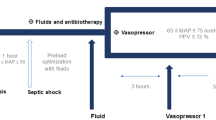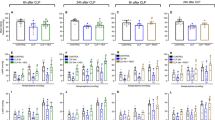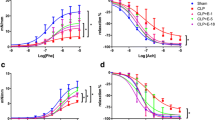Abstract
Purpose
Nitric oxide synthase (NOS) inhibitors were confirmed to correct the hypotension associated with septic shock, but the overall prognosis is often pessimistic. The histological findings failed to show any improvement. In fact, some patients even exhibited signs of exacerbation. The purpose of this study was to investigate the therapeutic effects of NOS inhibitors and catecholamines in dogs suffering from endotoxin shock. The histological changes produced by these agents were also evaluated.
Methods
Mongrel dogs were used under midazolam anesthesia. A PiCCO continuous cardiac output monitoring catheter was placed in the femoral artery, and a central venous monitoring catheter was placed in the external carotid artery.
Results
Endotoxin (0.5 mg/kg, i.v.) was administered to cause shock. After this shock state was observed, the NOS inhibitors and catecholamines raised the blood pressure, and norepinephrine (NA, 2 mg/kg/h) was found to be more potent than S-methylisothiourea (SMT, 20 mg/kg/h). The combined effects of SMT-NA or SMT-DOB were greater than those of NA or dobutamine (DOB) alone. The histological changes induced by endotoxin shock were not ameliorated by the administration of NOS inhibitors but instead appeared to be exacerbated to some degree.
Conclusion
NOS inhibitors combined with cathecholamines were thus suggested to be able to reduce the cathecolamine dosage in patients suffering from septic shock; They are thus considered to be hemodynamically effective agents.
Similar content being viewed by others
References
JR Parrat (1998) ArticleTitleNitric oxide in sepsis and endotoxaemia J Antimicrob Chemother 41 IssueIDsuppl A 31–9 Occurrence Handle10.1093/jac/41.suppl_1.31
T Evant A Carpenter H Kindermann J Cohen (1993) ArticleTitleEvidence of increased nitric oxide production in patients with sepsis syndrome Circ Shock 41 77–81
JL Vincent (1998) ArticleTitleCardiovascular alteration in septic shock J Antimicrob Chemother 41 IssueIDsuppl A 9–15 Occurrence Handle9511081 Occurrence Handle1:CAS:528:DyaK1cXhtlWjt78%3D Occurrence Handle10.1093/jac/41.suppl_1.9
FL Abel (1989) ArticleTitleMyocardial function in sepsis and endotoxin shock Am J Physiol 257 R1265–81 Occurrence Handle2690645 Occurrence Handle1:CAS:528:DyaK3cXnsVKksg%3D%3D
H Asakura Y Kamikubo A Goto Y Shiratori M Yamazaki H Jokaji et al. (1995) ArticleTitleRole of tissue factor in disseminated intravascular coagulation Thromb Res 80 217–24 Occurrence Handle8578548 Occurrence Handle1:CAS:528:DyaK2MXos1yqurY%3D Occurrence Handle10.1016/0049-3848(95)00170-V
LG Thijs JP de Baer MCM De Groot (1993) ArticleTitleCoagulation disorders in septic shock Intensive Care Med 19 S6–15 Occurrence Handle10.1007/BF01738944
JR Paratt (1973) ArticleTitleMyocardial and circulatory effects of E. coli endotoxin: modification of responses to catecholamines Br J Pharmacol 47 12–25
CM Paster TR Billiar (1995) ArticleTitleNitric oxide causes hyporeactivity to phenylephrine in isolated perfused livers from endotoxin-treated rats Am J Physiol 268 G177–82
S Moncada RMJ Palmer EA Higgs (1991) ArticleTitleNitric oxide. physiology, pathophysiology and pharmacology Pharmacol Rev 43 109–42 Occurrence Handle1852778 Occurrence Handle1:CAS:528:DyaK3MXmt1amtLw%3D
C Thiemermann J Vane (1990) ArticleTitleInhibition of nitric oxide synthases reduces the hypotension induced by bacterial lipopolysaccharides in the rat in vivo Eur J Pharmacol 182 591–5 Occurrence Handle2226626 Occurrence Handle1:CAS:528:DyaK3cXlsV2rsLg%3D Occurrence Handle10.1016/0014-2999(90)90062-B
A Petros D Benett P Vallance (1991) ArticleTitleEffect of nitric oxide synthase inhibitors on hypotension in patients with septic shock Lancet 338 1557–8 Occurrence Handle1720856 Occurrence Handle1:STN:280:By2D2sbmsVA%3D Occurrence Handle10.1016/0140-6736(91)92376-D
EA Minnard J Shou H Noama A Cech H Gallagher JM Daly (1994) ArticleTitleInhibition of nitrogen oxide synthase is detrimental during endotoxaemia Arch Surg 129 143–8
FM Robertson PJ Offner DP Ciere WK Becker BA Pruitt (1994) ArticleTitleDetrimental hemodynamic effects of nitric oxide synthase inhibition in septic shock Arch Surg 1239 149–56
C Szabo GI Southan C Thiemermann (1994) ArticleTitleBeneficial effects and improved survival in rodent models of septic shock with S-methylisothiourea sulfate in rodents: a potent and selective inhibition of inducible nitric oxide synthase Proc Natl Acad Sci USA 91 12472–6 Occurrence Handle7528923 Occurrence Handle1:STN:280:ByqC3cjpsl0%3D Occurrence Handle10.1073/pnas.91.26.12472
JS Aranow J Zhuang H Wang V Larkin M Smith MP Fink (1996) ArticleTitleA selective inhibition of inducible nitric oxide synthase prolongs survival in a rat model of bacterial peritonitis comparison with two nonselective strategies Shock 5 16–121
H Suga T Nakagawa N Miyoshi M Fukuda (2000) ArticleTitleComparison of nitric oxide production in the tissue following hemorrhagic invasion and endotoxin administration in rats in relation to pathogenesis of traumatic DIC J Tokyo Womens Med Univ 70 80–91 Occurrence Handle1:CAS:528:DC%2BD3cXisVemt7k%3D
K Ichimori H Ishida M Fukanori (1971) ArticleTitlePractical nitric oxide measurement employing a nitric oxide sensitive electrode Rev Sci Instrum 65 51–8
AK Nussler M Di Silvio TR Billar RA Hoffman DA Geller R Selby et al. (1992) ArticleTitleStimulation of the nitric oxide synthase pathway in human hepatocytes by cytokines and endotoxin J Exp Med 176 261–4 Occurrence Handle1377225 Occurrence Handle1:CAS:528:DyaK38Xks1yhsLY%3D Occurrence Handle10.1084/jem.176.1.261
A Waage P Brandtzaeg A Halstensen F Kierulf K Espevik (1989) ArticleTitleThe complex pattern of cytokines in serum from patients with meningococcal septic shock J Exp Med 169 333–8 Occurrence Handle2783334 Occurrence Handle1:STN:280:BiaD1c%2FkvFM%3D Occurrence Handle10.1084/jem.169.1.333
S Moncada A Higgs (1993) ArticleTitleThe L-arginine-nitric oxide pathway N Engl J Med 329 IssueID27 2002–11 Occurrence Handle7504210 Occurrence Handle1:CAS:528:DyaK2cXhsF2ntrw%3D Occurrence Handle10.1056/NEJM199312303292706
Author information
Authors and Affiliations
Rights and permissions
About this article
Cite this article
Suga, H., Nakagawa, T., Soga, Y. et al. Reinforcement Therapy Using Nitric Oxide Synthase Inhibitors Against Endotoxin Shock in Dogs. Surg Today 36, 811–817 (2006). https://doi.org/10.1007/s00595-006-3248-z
Received:
Accepted:
Issue Date:
DOI: https://doi.org/10.1007/s00595-006-3248-z




